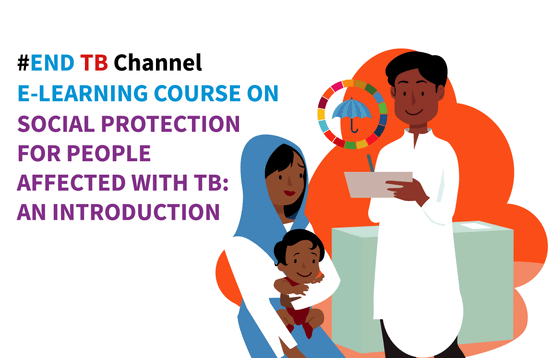
Although social protection is a human right, most of the global population is not yet covered by any form of social protection, leaving billions of people outside the welfare system.
Social protection and poverty alleviation are also key components of the End TB Strategy; however, most countries are not yet including social protection in the programmatic response to TB in a comprehensive and sustainable way.
This course will introduce you to the concept of social protection, its role in ending the TB epidemic, the different forms of social protection, and the evidence for the impact on TB.
Language: English
Intermediate (Intermediaire), Tuberculosis
Course information
Overview: This e-learning course was developed by WHO. It is a self-paced online course that builds on the WHO guidance on social protection for people affected by tuberculosis (2024).
Course duration: About 1 hour.
Certificate: At the end of the course, you can download a certificate of participation.
Course version: This is “Version 1.0” of this online course. At the end of the course, you will have the opportunity to share your feedback in a course evaluation survey. Please take the time to share your experience and opinions. Your feedback will be used to refine and update the course in order to produce a “Version 2.0”.
© World Health Organization 2024. All rights reserved. This e-learning training was developed by the World Health Organization (WHO). It is intended to be used as a self-learning course for health-care workers on the management of tuberculosis in children and adolescents. All reasonable precautions have been taken by WHO to verify the information contained in this e-learning training. However, the e-learning training is being distributed without warranty of any kind, either expressed or implied. The responsibility for the interpretation and use of the e-learning training lies with the reader. In no event shall WHO be liable for damages arising from its use.The designations employed and the presentation of the material in this publication do not imply the expression of any opinion whatsoever on the part of WHO concerning the legal status of any country, territory, city, or area or of its authorities, or concerning the delimitation of its frontiers or boundaries. Dotted and dashed lines on maps represent approximate border lines for which there may not yet be full agreement. The mention of specific companies or of certain manufacturers’ products does not imply that they are endorsed or recommended by the World Health Organization in preference to others of a similar nature that are not mentioned. Errors and omissions excepted; the names of proprietary products are distinguished by initial capital letters.
What you'll learn
- describe the concepts and definitions used in social protection
- outline the determinants of TB and their impact on the global response
- explain the role of social protection in the context of the End TB strategy
- compare TB-sensitive and TB-specific approaches for implementing social protection for people affected by TB
- summarize the key evidence on the potential impact of social protection on the TB epidemic
Who this course is for
- This e-learning course was developed to provide essential knowledge for anyone interested in social protection in general and for people affected by tuberculosis. Therefore, the course may be of interest to ministries of health, other ministries, national TB programmes, technical agencies, NGOs, consultants, WHO staff, and health workers.
Course contents
Course introduction
Module 1: Social protection for people affected by TB – introduction:
This module addresses the concept of social protection and its role in TB care and prevention.End of course
End of course evaluation
Acknowledgments
Enroll me for this course
Certificate Requirements
- Gain a Confirmation of Participation by completing at least 80% of the course material.
- Gain an Open Badge by completing the course.